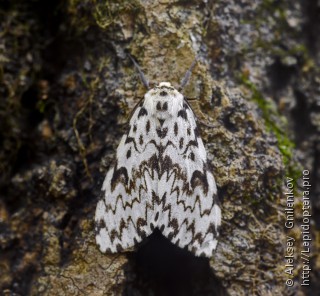Lymantria monacha (Linnaeus, 1758)

Taxonomy
class Insecta → subclass Pterygota → infraclass Neoptera → superorder Holometabola → order Lepidoptera → superfamily Noctuoidea → family Erebidae → subfamily Lymantriinae → tribe Lymantriini → genus Lymantria → species Lymantria monacha
Species name(s)
Lymantria monacha (Linnaeus, 1758) = Phalaena monacha Linnaeus, 1758 = Bombyx nigra Freyer, 1833 = Liparis eremita Ochsenheimer, 1810 = Lymantria monacha matuta Bryk, 1949 = Lymantria monacha chosenibia Bryk, 1949 = Lymantria monacha lateralis Bryk, 1949 = Lymantria monacha idae Bryk, 1949 = neirai Agenjo, 1959 = ceballosi Agenjo, 1959 = Liparis monacha. [9, 10]
Black Arches.
urn:lsid:insecta.pro:taxonomy:6951
Expansion
This species marks on the maps: 3.
Zoogeographical regions
Palaearctic.
Russia regions
#1. Kaliningradsky; #4. Evropeisky Severo-Zapadny; #6. Evropeisky Severo-Vostochny; #7. Evropeisky yuzhno-tayozhny; #8. Evropeisky Tsentralny; #9. Evropeisky Tsentralno-Chernozyomny; #10. Sredne-Volzhsky; #11. Volgo-Donsky; #13. Zapadno-Kavkazsky; #14. Vostochno-Kavkazsky; #16. Sredne-Uralsky; #17. Yuzhno-Uralsky; #19. Sredneobsky; #20. Yuzhno-Zapadnosibirsky; #22. Krasnoyarsky; #23. Predaltaisky; #24. Gorno-Altaisky; #25. Tuvinsky; #26. Predbaikalsky; #36. Sredne-Amursky; #37. Nizhne-Amursky; #38. Sakhalin; #39. Yuzhno-Kurilsky; #40. Primorsky.
Forewing length
18—26 mm.
Wingspan
40—55 mm.
Primary colors
Brown/Gray/Black, White.
Flight time
| January | February | March | April | May | June | July | August | September | October | November | December |
Larva lifespan
| January | February | March | April | May | June | July | August | September | October | November | December |

Detailed information with references
Distribution
- Albania, Austria, Belgium, Bulgaria, Great Britain, Hungary, Germany, Greece, Denmark, Ireland, Spain, Italy, Corsica, Latvia, Lithuania, Luxembourg, Netherlands, Norway, Poland, Portugal, Romania, Slovakia and the Soviet Union - the European part of Finland France, Czech Republic, Switzerland, Sweden, Estonia, Yugoslavia. [1].
- Albania, Andorra, Belarus, Belgium, Bulgaria, Bosnia and Herzegovina, the British Isles, France, Germany, Greece (mainland), Denmark (mainland), Ireland, Spain (mainland), Italy (mainland), Corsica Latvia, Liechtenstein, Lithuania, Luxembourg, Macedonia, Moldova, the Netherlands,Norway (mainland), the Channel Islands, Poland, Portugal (mainland), Russia, Romania, Slovakia, Slovenia, Ukraine, Finland, France (mainland), Croatia, Czech Republic, Switzerland, Sweden, Estonia, Yugoslavia. [10].
- Regions of the Russian Federation: the Volga-Don, East Caucasus, Gorno-Altaisk, the European North-East, the European North-West, the European Central Black Earth, the European Central European South taiga, the Western Caucasus, Kaliningrad, Krasnoyarsk, Nizhny-Amur, Prealtay, of Baikal, Primorye, Sakhalin,Mid-Amur, the Volga-Average, Average Urals, Sredneobskaya, Tuva, South West Siberian Yuzhno-Kuril, South Ural. [3].
- Range: temperate Eurasia. In the north-up to Central Sweden and Southern Finland. [85].
Imago Habitus and Differences from alike species
- Forewing length - from 1.8 to 2.6 cm (males are smaller than females). The wings are white, with numerous dark toothed stripes and spots, and there are also completely black forms, and their number can reach up to half of the total number of individuals of this species. The hindwings are beige, with black dots along the edges. [85].
General info about Imago
- The nun flies in spruce and pine forests, especially in frequently planted and divided by age (for example, in artificial plantings). In addition to conifers, butterflies can also be found in mixed forests. Mass reproduction usually occurs in coniferous forests. [85].
Imago lifespan
- Adults fly from July to early September, in one generation. [85].
General info about Larva
- After hatching, the caterpillars stay together for a while, then climb to the upper tiers of the tree crown, and there they spread out singly. In windy weather, the caterpillars are wrapped in a silk web, in this form they are carried by the wind to other trees. During mass breeding seasons, nun larvae can serve as food for Lithosia quadra caterpillars. [85].
Larva food plants / other food objects
- Quercus, Salix, Carpinus, Tilia, Fagus, Picea, Pinus. [28].
- Различные виды деревьев, особенно сосна и ель. При объедании всего растения целиком могут переходить и на травянистые растения. В годы массового размножения может наносить значительный урон, например, посадкам ели (одна гусеница поедает до 1000 хвоинок и еще столько же надкусывает!) [85].
Larva lifespan
- The caterpillars will live from the end of April to June. [85].
Egg
- Lymantria monacha females lay eggs in small groups (from 20 to 100 pieces) under the bark of trees or on smooth trunks under lichens, as a rule, in the lower part of the trunk, although during mass reproduction they can also be deposited in the crowns. Just one butterfly can lay up to 300 eggs, each time choosing a tree that has not yet been affected by nuns. [85].
Subspecies of Lymantria monacha
- Lymantria monacha monacha. [9]
- L. m. yunnanensis Collenette, 1933. [9]
Authors
Initial species uploading to the site: Peter Khramov.
Photos:
Aleksey Gnilenkov, Oleg Seliverstov. Text data: Peter Khramov.
The species characteristics formalization: Peter Khramov, Vasiliy Feoktistov.
References
- [1] O. Karsholt, J. Razowski (eds.), 1996. The Lepidoptera of Europe: a distributional checklist
- [3] Каталог чешуекрылых (Lepidoptera) России. Под ред. С. Ю. Синёва. СПб.; М.: Товарищество научных изданий КМК, 2008
- [9] Tree of Life (funet.fi), 2012
- [10] de Jong, Y.S.D.M. (ed.) (2011) Fauna Europaea version 2.4 (faunaeur.org)
- [28] Moths and Butterflies of Europe and North Africa (leps.it), 2012
- [85] Lepidoptera species catalogue, Lepidoptera.ru, 2015
Comments
Note: you should have a Insecta.pro account to upload new topics and comments. Please, create an account or log in to add comments
Lymantria monacha photos
Other species Lymantria





































































